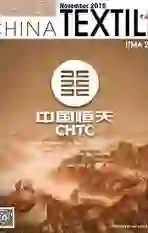VDMA:Almost covering all sectors in the show
2015-12-28ByGaoHuabinZhaoZ
By+Gao+Huabin+Zhao+Zihan
Facing the impacts of the economic slowdown in China to the production and sales in Italy, President Dr. Reinhold Festge told the reporter that“In general we observe a certain slowdown of our business in China, as well for exports from Germany as for locally manufactured products. However, there are still customers investing in new and highly automated production lines in order to meet the global completion. Some branches (automotive, aircraft, wind energy, etc.) invest heavily in technical textiles and composites for light weight products to fulfill the Chinese political targets to reduce air pollution and abundant consumption of resources. The German industry is prepared to support its Chinese customers tackling the future demands.”
Today, many developing countries such as India and Vietnam are enjoying rapid development of textile industry, and their demand for textile machinery in Europe is to grow. However, according to Festge, “China is and will remain a very important market for German textile machinery manufacturers. We do not expect that outsourcing of garment production will drastically affect the production of yarn, woven or knitted products. Chinas production chain covers all production steps, is highly competitive and able to meet highest quality and performance demands from large buyers much better than smaller industries in other countries.”
As for the characteristics Italian textile machinery sale has presented till now, Festge said that “Sustainability has become more and more important in textile production. Already in the run-up to ITMA, VDMA together with member companies published practical examples like functional integration which is a classic instrument of textile machinery engineering in order to shorten long processes. Such technical solutions enable more efficiency, reduce material consumption and make work flows easier for the operating staff – which means that they are concrete examples of sustainability. Other examples were covering the topic energy efficiency. We have undertaken calculations on energy efficiency not just for one machine or process step but over the entire production process of defined products like cotton T-Shirt, a functional T-Shirt or a textile billboard. The results prove: German textile machinery of today needs about 30 percent less energy compared to German technology 10 years ago. In other words: Sustainability meets profit. Let me describe a simple picture for the saving potential with the example of producing functional T-shirts: 125 million are produced per year worldwide. Possible energy savings for the process steps from yarn manufacturing over warp-knitting up to finishing sum up to more than 23 billion watt hours per year. If your brain does not usually compare in watt hours, think of energizing more than half a million notebooks per year.”
Compared with the European textile equipment products, “The larger units in the textile machinery sector worldwide tend to have a more global set-up. This applies for European but also for Chinese manufacturers. Therefore the question of gaps has to be discussed on a much more specific level of product groups and even the respective competitors.”
According to Festge, Germany will be the second strongest country at ITMA with about 240 exhibitors out of more than 1,600 in total. They occupy more than 20 thousand square meters of booked space. German exhibitors will cover almost all different machinery chapters with a strong focus on manmade fiber, nonwovens, spinning, winding, knitting, weaving and finishing technology. Not only state-of-the-art machinery and but also complete production lines will be exhibited and it is also worth to mention that German research institutes will be well presented in the Research & Innovation Pavilion in hall 8.
